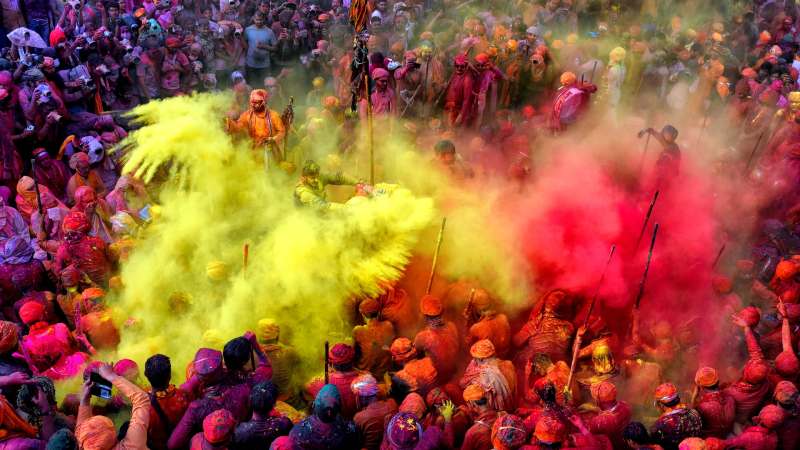One of the best-known Holi traditions is when revelers dressed in all white take to the streets and throw colorful powder at each other, leaving behind a kaleidoscope of pigment and joy. A celebration of music, dancing and food follows.
When is the holiday celebrated?
Holi is celebrated at the end of winter and beginning of spring, on the last full moon day of the month of Falgun in the Hindu lunisolar calendar. The dates of the festival vary depending on the lunar cycle. It usually falls in March and this year it is celebrated on March 25th.
What stories are associated with Holi?
This holiday has its origins in Hindu mythology and tradition.
In the origin story, King Hiranyakashipu ordered everyone in his kingdom to worship him, but when his own son Prahalad, a devotee of Lord Vishnu, disobeyed the command, he became furious. So he ordered her sister Holika, who was not affected by fire, to carry her child Prahlad in her lap into the bonfire. However, when the fire was lit, the boy was protected by his devotion to Lord Vishnu and escaped unharmed, but Holika was burnt despite her immunity.
Holi refers to the cosmic interaction of Lord Krishna and his love for his beloved Radha and His companions and devotees called ‘Gopikas’ who are revered for their unconditional love and devotion to Krishna. Some people think it is.
How is the Festival of Colors celebrated?
In many parts of India, people light large bonfires on the eve of the festival to symbolize the destruction of evil and the triumph of good.
On the day of Holi, the streets and the entire city are full of people throwing colored powder into the air. Some people throw balloons filled with colored water from rooftops or use spray guns. During the day, anything is fair game. Throughout the city, you can hear cries of “Holy Hai!”, which means “Holi!”. The festival of Holi has been romanticized and popularized in Bollywood films for decades.
The colors seen during Holi symbolize different things. Blue represents the skin color of Lord Krishna, while green symbolizes spring and rebirth. Red symbolizes marriage and fertility, and red and yellow, which are often used in rituals and rituals, both symbolize auspiciousness.
Although the celebration includes many special foods, the most popular food at Holi is gujia, a deep-fried sweet puff pastry stuffed with milk curd, nuts and dry fruits. Holi parties also have ‘thandai’, a cold drink made with almonds, fennel seeds, rose petals, poppy seeds, saffron, milk and sugar.
How are holidays celebrated in the diaspora?
In North America and countries with large Hindu populations, people of Indian descent celebrate Holi with Bollywood parties and parades, as well as a variety of public and private gatherings. Celebrate the festival. It is also common for Hindu temples and community centers to organize cultural programs, friendly cricket matches, and other celebratory events during the holidays.
- Top 5 Health Insurance Stocks to Add to Your Portfolio - July 26, 2024
- 7 Reasons Edamame is Great for Your Health - July 26, 2024
- 2024 Paris Olympics: How Many US Athletes Are Competing? - July 26, 2024





